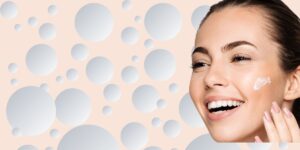Introduction
The skin is the largest and outermost organ in the human body and provides protection for the body from the outside environment. Part of that protection involves protection from the oxidative stress from UV-induced radiation which causes tissue damage and premature skin aging. Anti-oxidant components contained within the skin are responsible for the skin’s anti-oxidant defence1.
Caffeic acid, a natural organic acid, has powerful anti-oxidant properties. It is found naturally in coffee and is a major metabolite of chlorogenic acid, one of the main biologically active ingredients of coffee2. Typical consumption of coffee results in ingestion of up to 250-500mg of caffeic acid per day2. Caffeic acid has been shown to have many skincare benefits when topically applied to the skin (see below). However, due to poor water and organic solvent solubility, caffeic acid has limited ability to permeate the skin barrier using normal, traditional skincare formulations3,4.
Skin Benefits of Caffeic Acid Application
“Besides powerful antioxidant activity, increasing collagen production and prevention of premature aging, caffeic acid has demonstrated antimicrobial activity and may be promising in the treatment of dermal diseases.”5
The following is a list of some of the commonly used studied skincare benefits provide by topical application of Caffeic acid:
Anti-aging Activity – Collagen Protection
Caffeic acid has been shown to exhibit anti-oxidant activities and can eliminate the action of free radicals in damaging the skin.5UVA radiation induced free radicals can cause clinical, biochemical and histological changes in the skin through changes in cells and in extracellular matrix proteins, including collagen, responsible for the structural integrity of the skin 5. These changes cause premature skin aging and can lead to increased risk of skin cancer. The natural aging of the skin associated with the action of free radicals causes a reduction in skin hydration, pigmentation, fine wrinkles, signals from sagging and increased possibility of the occurrence of neoplasm diseases. Another change is the reduction of dermal collagen that makes the skin thinner.
UV Radiation Protection
Topically applied caffeic acid and ferulic acid have beed demonstrated to, when topically applied, provide protection against UV radiation-induced skin damage6. Further, skin permeation was not influenced by formulation pH.
“Given that UV radiation penetrates deeply into the skin, topically applied antioxidant drugs can afford to the skin a satisfactory photoprotection only if they are able to reach deeper cutaneous layers, permeating through the stratum corneum”.6
Antimicrobial Activity
Caffeic acid has demonstrated pronounced antimicrobial activities in cosmetic formulation showing antimicrobial effect against various micro-organisms studied.5
Anti-cancer Activities
Another study has shown that caffeic acid may act as a potent chemoprotective agent against skin cancer 2. Caffeic acid was shown to block the activity of one compound responsible for causing skin cancer.
Discussion
Caffeic acid offers proven skin anti-aging skincare benefits as well as antimicrobial and possibly anti-cancer benefits5. To effectively realise these skincare benefits, product formulations containing caffeic acid must deliver it deep into the skin layers to where UVA radiation can penetrate3. The poor solubility of caffeic acid in water and organic solvents has limited skin permeation of caffeic acid3. Recent advances in microemulsion studies have proved that these represent an efficient skin delivery method for enhancing skin permeation of caffeic acid
“Advances in nanotechnology have opened new opportunities for the delivery of molecules to the hair follicle as they can accumulate into these structures releasing drugs for an extended period.”7
Enhanced Skin Permeation for Caffeic Acid
“For hydrophilic compounds, the stratum corneum works as a barrier. Therefore, to apply chlorogenic acid for topical purposes, it is necessary to improve interadermal delivery. Microemulsions offer a potential use as vehicle to protect skin against UV-induced damage.”3
Next generation formulation methods are better able to enhance skin permeation of caffeic acid so that its UV protective effects can apply to deeper skin layers. Our Vitamin C Serum and our C E Ferulic Serum contain both ferulic and caffeic acids in a microemulsion based formulation. Our nano-encapsulated Green Micelle™ formulations increase formulation solubility of caffeic acid and enhance skin permeation for superior UV anti-aging protection.
“Increased attention has been paid to nanomedicine as a method of applying antioxidants topically”.1
References
- 1.Aljuffali I, Hsu C, Lin Y, Fang J. Cutaneous delivery of natural antioxidants: the enhancement approaches. Curr Pharm Des. 2015;21(20):2745-2757. doi:10.2174/1381612821666150428125428
- 2.Kang NJ, Lee KW, Shin BJ, et al. Caffeic acid, a phenolic phytochemical in coffee, directly inhibits Fyn kinase activity and UVB-induced COX-2 expression. Carcinogenesis. Published online October 8, 2008:321-330. doi:10.1093/carcin/bgn282
- 3.Kitagawa S, Yoshii K, Morita S, Teraoka R. Efficient topical delivery of chlorogenic acid by an oil-in-water microemulsion to protect skin against UV-induced damage. Chem Pharm Bull (Tokyo). 2011;59(6):793-796. doi:10.1248/cpb.59.793
- 4.Yutani R, Kikuchi T, Teraoka R, Kitagawa S. Efficient delivery and distribution in skin of chlorogenic acid and resveratrol induced by microemulsion using sucrose laurate. Chem Pharm Bull (Tokyo). 2014;62(3):274-280. doi:10.1248/cpb.c13-00820
- 5.Magnani C, Isaac VLB, Correa MA, Salgado HRN. Caffeic acid: a review of its potential use in medications and cosmetics. Anal Methods. Published online 2014:3203-3210. doi:10.1039/c3ay41807c
- 6.Saija A. In vitro and in vivo evaluation of caffeic and ferulic acids as topical photoprotective agents. International Journal of Pharmaceutics. Published online April 10, 2000:39-47. doi:10.1016/s0378-5173(00)00358-6
- 7.Carolina O, Spagnol C, Guillot A, Melero A, Corrêa M. Caffeic acid skin absorption: Delivery of microparticles to hair follicles. Saudi Pharm J. 2019;27(6):791-797. doi:10.1016/j.jsps.2019.04.015












